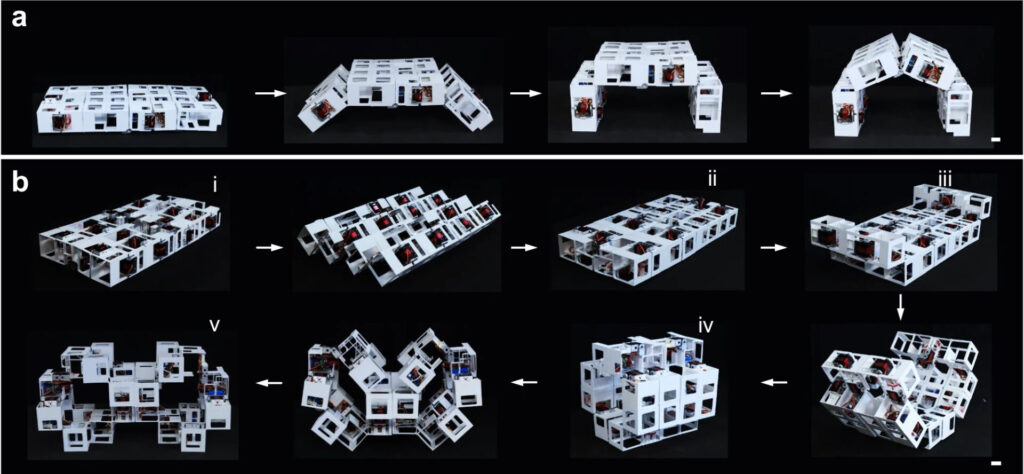Featured image: origami-based robotic metastructure. Li et al., Adaptive hierarchical origami-based metastructures, Nature Communications 15, 6247 (2024), CC BY 4.0.
Key Takeaways
- Rigid origami principles enable robots to transform into over 1,000 shapes.
- Dr. Jie Yin’s transformer bots use minimal power to carry three times their weight.
- Origami-inspired robots have potential applications in space exploration and disaster response.
- The fusion of AI with origami robotics could lead to adaptive, self-evolving machines.
Remember the last time you folded a paper airplane? Little did you know, you were tapping into a world of scientific potential. Welcome to the fascinating realm where origami — yes, the art of paper folding — is revolutionizing robotics and bringing us closer to the shape-shifting marvels we’ve only seen in movies.
Table of Contents
The Rigid Revolution
But we’re not talking about your typical paper cranes here. Enter rigid origami, the rebellious cousin of traditional paper folding. Imagine origami made of stiff cardboard instead of flimsy paper. That’s the essence of rigid origami — flat, unyielding panels connected by flexible hinges.
“But wait,” you might say, “how can something rigid be folded?” Excellent question! The magic lies in those hinges. While the panels stay flat and strong, the hinges allow for precise, controlled movement. It’s like a high-tech pop-up book for engineers.
Meet the Mastermind: Dr. Jie Yin
At North Carolina State University, Dr. Jie Yin and his team are taking rigid origami to mind-bending new heights. They’ve created robots that would make even the most advanced Transformers jealous. These bots can morph into over 1,000 different shapes. Yes, you read that right — one thousand!
The Secret Sauce: 3D-Printed Cubes and Clever Hinges
Dr. Yin’s transformer bots are built from hollow plastic cubes, each one a marvel of 3D printing. These cubes are connected by a network of hinges — some fixed, others controlled wirelessly. Here’s the kicker: with just three motors, these bots can rearrange themselves into an astounding array of forms.
Picture this:
- A robot that stretches into a tunnel for exploration
- The same bot morphing into a sturdy bridge
- Then, it transforms again into a multi-story structure
It’s like having a Swiss Army knife, but instead of tools, you have an entire shape-shifting robot at your disposal.
Why This Matters: Beyond Cool Factor
Now, you might be thinking, “Okay, that’s impressive, but why should I care?” Excellent point! Let’s break down why these origami-inspired robots are more than just fancy party tricks.
Space: The Foldable Frontier
Imagine launching a spacecraft with compartments that unfold into expansive living quarters once in orbit. Or picture a Mars rover that can reshape itself to navigate treacherous terrain. These aren’t far-fetched dreams — they’re potential applications of Dr. Yin’s research.
Disaster Response: Transforming Hope
When disaster strikes, every second counts. Enter our origami robots:
- They arrive compact, easily transportable to affected areas
- Unfold into bridges, providing safe passage over debris
- Transform again into shelters for those displaced
- Morph once more into mobile medical units
One robot, multiple life-saving functions. Now that’s efficiency!
Everyday Innovation
But let’s bring it closer to home. The principles behind these transformer bots could revolutionize:
- Foldable smartphones that expand into tablets
- Furniture that adapts to your space needs
- Camping gear that’s compact yet incredibly versatile
The possibilities are as limitless as your imagination (and maybe a bit beyond).

The Science Behind the Sorcery
Now, let’s get a bit nerdy (in the best way possible). The magic of these transformer bots lies in their adherence to rigid origami principles. Each transformation is a carefully choreographed dance of panels and hinges.
The Power of Precision
In rigid origami, every fold matters. A millimeter off, and the whole structure fails. Dr. Yin’s bots take this precision to the extreme. Each cube, each hinge, each motor is positioned with exacting accuracy. It’s like conducting an orchestra where every instrument must play perfectly for the symphony to work.
Efficiency: Doing More with Less
Here’s a mind-bending fact: these bots can carry up to three times their own weight. That’s like you effortlessly lifting a small car. And they do all this shape-shifting with minimal power. No bulky batteries or complex control systems needed. It’s origami efficiency at its finest.
From Fiction to Fact: The Transformer Connection
Let’s indulge our inner sci-fi geeks for a moment. The parallels between Dr. Yin’s bots and the Transformers are uncanny:
- Multiple forms from a single structure? Check.
- Maintaining strength while shape-shifting? Double-check.
- Adapting to various situations? Triple-check.
But unlike their fictional counterparts, these real-world transformers don’t need Hollywood special effects. They rely on good old-fashioned science and engineering (with a dash of origami magic).
The Future: Unfolding Possibilities
As exciting as Dr. Yin’s current work is, it’s just the beginning. The future of origami-inspired robotics is bright and full of potential.
AI Meets Origami
Imagine robots that not only change shape but learn and adapt. Artificial intelligence could allow these bots to evolve their transformations, creating new forms we haven’t even thought of yet.
Micro-Machines, Macro-Impact
While Dr. Yin’s current bots are visible to the naked eye, the principles could be applied at a microscopic level. Picture medical nanobots that unfold inside the body, delivering targeted treatments or performing minimally invasive surgeries.
Sustainable Shapeshifters
As we grapple with environmental challenges, these adaptable structures could play a crucial role. From buildings that adjust to changing climates to products that transform instead of being discarded, origami robotics could be a key player in a more sustainable future.
Folding It All Together
From children’s paper planes to shape-shifting robots, origami has come a long way. Dr. Jie Yin’s research isn’t just pushing the boundaries of robotics; it’s redefining what’s possible when art meets science.
As we stand on the brink of this origami-inspired revolution, one thing is clear: the future is unfolding before our eyes, one crease at a time. And who knows? The next time you fold a paper airplane, you might just be inspiring the next big breakthrough in robotics.
So, keep folding, keep imagining, and keep an eye out for robots in disguise. They might not be fighting Decepticons, but they could be building a bridge, exploring Mars, or revolutionizing your smartphone. The origami robots are here, and they’re ready to transform our world.




